Understanding the Role of Dummy Eggs for Finches
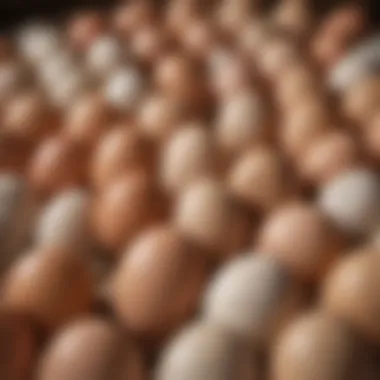
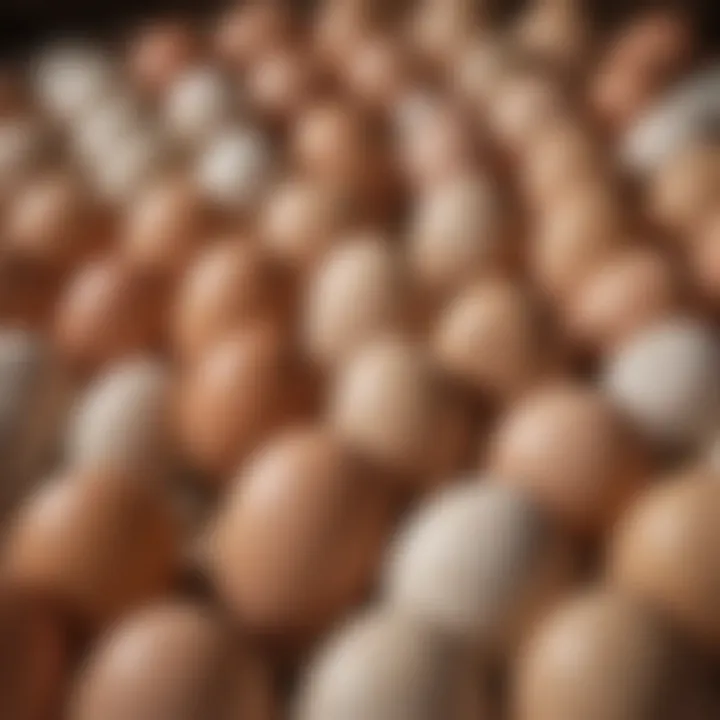
Intro
The use of dummy eggs for finches is a practice that offers both practical benefits and insights into avian behavior. Artificial eggs serve a critical role in helping finch owners manage breeding scenarios. Understanding the purpose of these dummy eggs can lead to better breeding practices, healthier birds, and a more fulfilling experience for pet owners. This article delves into key aspects, from material choices to behavioral implications, all tailored to enhance your journey as a finch enthusiast.
Understanding Your Pet
Pet Behavior Basics
Understanding finch behavior is fundamental. Finches exhibit intricate social interactions and nesting behaviors. In their natural habitats, they build nests using materials like twigs and leaves. Introducing dummy eggs into their environment can mimic the nesting process, prompting hormonal and behavioral changes. This can be particularly beneficial during breeding seasons.
Common Breed Characteristics
Different finch breeds have unique characteristics. For instance, Zebra finches are known for their adaptability and social nature. In contrast, Society finches are often seen as more docile. Recognizing these traits can aid owners in selecting the most suitable dummy eggs that align with their specific breed's needs, thus enhancing breeding success.
Species-Specific Needs
Each finch species has its own nesting preferences. Some prefer to keep their nests clutter-free while others might thrive in a more filled environment. Knowing these preferences can guide the placement and type of dummy eggs used. This understanding is crucial for creating a suitable habitat that encourages breeding and reduces stress.
The Role of Dummy Eggs
Dummy eggs serve multiple purposes in finch care. They can help stimulate breeding behavior, reduce anxiety, and encourage nesting instincts. For those finch owners seeking to breed their pets, dummy eggs provide a non-invasive way to replicate natural conditions.
Material Selection
When choosing dummy eggs, the material is an important factor. Common options include ceramic and plastic. Ceramic eggs are durable and offer a realistic weight, while plastic ones are lightweight and less likely to cause injury. The choice primarily depends on the owner's preference and the specific needs of their finches.
Behavioral Implications
Introducing dummy eggs impacts finch behavior significantly. The presence of these eggs may stimulate mating behaviors and increase the likelihood of nesting. This can lead to elevated stress if the eggs are not handled properly. Educating yourself on how to use them is vital for maintaining a healthy environment.
Maintaining Dummy Eggs
Caring for dummy eggs requires regular maintenance. Here are some practical tips for finch owners:
- Clean Regularly: To keep the dummy eggs in good condition, clean them periodically with warm soapy water.
- Monitor Interaction: Observe how your finches interact with the eggs. Changes in behavior can indicate if the eggs are having the desired effect.
- Replace as Needed: If the eggs become damaged or worn, consider replacing them to maintain their efficacy.
Dummy eggs can dramatically influence the breeding habits of finches and must be used carefully for the best results.
Finale
Understanding the role of dummy eggs in finch care is essential for any finch owner. By tailoring your approach to the needs of your specific birds, you enhance their breeding experience and overall wellbeing. As you integrate these insights into your care regimen, you’ll likely observe a positive shift in both their behavior and health.
Prologue to Dummy Eggs for Finches
Dummy eggs play a vital role in the breeding practices of finches. These non-functional eggs offer numerous advantages, primarily addressing the complexities of finch breeding behavior. Understanding this topic is essential for pet owners who wish to foster a healthy and stress-free environment for their birds.
The primary purpose of dummy eggs is to support finches during their breeding cycles. By simulating a full clutch, dummy eggs can encourage natural nesting behaviors in these birds. This is particularly important since finches, like many other avian species, exhibit strong instincts related to reproduction and nurturing. When they observe dummy eggs in their nesting boxes, they may feel more secure in their breeding activities.
Considering the benefits of using dummy eggs, it becomes clear that they also mitigate stress in finches during the nesting period. By providing a realistic alternative, dummy eggs can alleviate the anxiety associated with incomplete nests. They help create an ideal setting where finches can focus on mating and rearing their young without the fear of being unable to lay eggs.
Dummy eggs help finches feel secure in their nesting environment, promoting natural behaviors while reducing stress.
Moreover, understanding the construction of dummy eggs and their placement in nesting scenarios can significantly enhance the efficacy of this practice. Pet owners must be informed regarding the material selection, size, and shape of these eggs, as these factors can directly influence how finches interact with them. Therefore, it is essential to explore the aspects of dummy eggs in detail to fully appreciate their value in finch care. This will provide insights that pet owners, both novice and experienced, can utilize to improve their breeding practices.
Ultimately, the effective use of dummy eggs not only supports finches during the reproductive cycle but also improves the overall breeding experience for pet owners. This introduction sets the stage for a deeper exploration into the materials, designs, and strategies pertaining to dummy eggs, making it a critical aspect in understanding their role in the lives of finches.
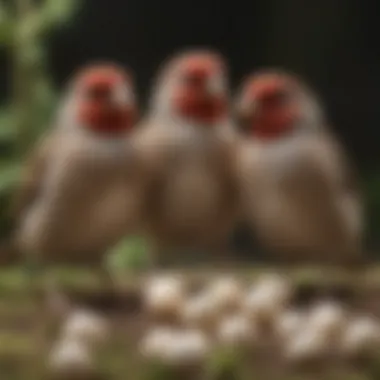
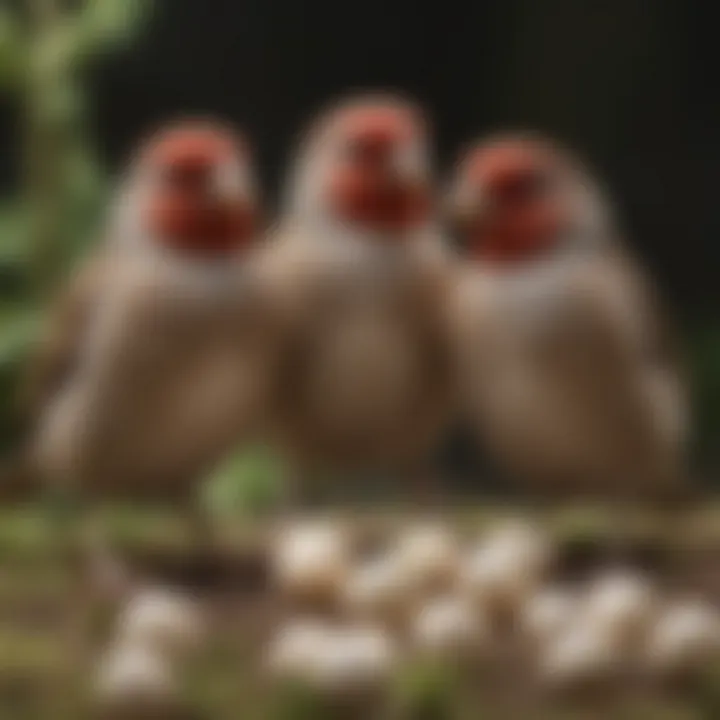
The Purpose of Dummy Eggs
Dummy eggs serve a significant role in the breeding management of finches. By understanding their purpose, pet owners can make informed decisions to enhance the reproductive experience for both the birds and themselves. The use of dummy eggs is not merely arbitrary; it addresses specific concerns related to finch breeding behaviors, emotional well-being, and nesting practices.
Understanding Finch Breeding Behavior
Finches are species deeply influenced by their instincts. Their breeding behaviors are often governed by environmental cues. In a natural setting, female finches typically display a strong inclination to build nests and lay eggs as part of their reproductive cycle. The presence of realistic-looking dummy eggs can mimic the conditions under which these finches would naturally lay eggs, thereby triggering these instincts.
Additionally, it is important to note that finches can exhibit nesting behaviors even without the natural stimulus of real eggs. This leads to unease if their instincts are high and they cannot lay eggs. Dummy eggs mitigate this stress by providing a focus for their nesting drive.
By comprehensively observing behavior changes when dummy eggs are employed, owners can gain insights into possible stressors or improvements in breeding results. These observations can inform future breeding strategies, as certain behaviors may indicate readiness or reluctance to continue the breeding cycle.
Simulation of Egg Laying
The simulation of egg laying is a process finch owners can utilize to their advantage. Dummy eggs create a reversible scenario that assists finches in engaging in their natural reproductive behaviors without the complications that may arise from real eggs. For instance, using dummy eggs can decrease the anxiety and stress that often accompany the act of laying eggs, especially if female finches are having difficulties.
Moreover, the introduction of dummy eggs can lead to increased social interaction between breeding pairs. This interaction is essential for establishing a healthy mating dynamic. By simulating the experience of laying eggs, it encourages the natural instincts of the birds while alleviating some of the pressures involved in real egg production.
In summary, understanding the purpose of dummy eggs in finch care provides crucial insights into their breeding behaviors. Through thoughtful implementation, these tools not only enhance the avian experience but also empower owners to advocate for the well-being of their pets.
Material and Design of Dummy Eggs
The material and design of dummy eggs plays a crucial role in simulating a natural environment for finches during their breeding period. Utilizing the appropriate materials and understanding the importance of size and shape can significantly influence the birds' behavior and overall well-being. This section will delve into the specific elements that contribute to effective dummy egg implementation.
Types of Materials
When it comes to materials, several options are available for crafting or purchasing dummy eggs. The goal is to choose materials that mimic the texture and weight of real eggs.
- Plastic: Commonly used, plastic dummy eggs are lightweight and easy to clean. They usually come in various colors and can resemble multiple species of finch eggs.
- Ceramic: These eggs feel more natural due to their weight and realistic look. However, care must be taken to prevent breakage if the finches become particularly energetic.
- Wood: Wooden eggs provide a natural option, but they may not always accurately portray the heft that finches expect.
The choice of material can affect how finches interact with the dummy eggs, thus impacting their nesting behavior.
Size and Shape Considerations
An equally important aspect in the design of dummy eggs is ensuring they accurately replicate the size and shape of the eggs finches naturally lay.
- Size: Size variations occur between different finch species. Dummy eggs must be chosen based on the particular species to avoid confusion. A mismatch can lead to stress or abandonment of eggs.
- Shape: The typical finch egg has an oval shape. Using eggs that closely resemble this shape helps further reduce any potential behavioral anomalies.
Properly sized and shaped dummy eggs promote natural nesting behaviors in finches, leading to a healthier environment overall.
Implementation Strategies for Dummy Eggs
Incorporating dummy eggs into the care of finches requires careful planning and execution. This section emphasizes the importance of implementation strategies for dummy eggs. These strategies not only optimize the effectiveness of dummy eggs but also enhance the overall experience for both pet owners and finches. Proper implementation ensures that the finches respond to these dummy eggs positively, mimicking natural behaviors that are vital for their well-being.
Choosing the Right Time
Timing plays a crucial role in the effectiveness of dummy eggs. Introducing them at the appropriate moment can significantly influence how finches react and adapt during the breeding season. Typically, pet owners should introduce dummy eggs during the initial stages of the breeding cycle. This is when the female finch is more inclined to accept them as part of the nesting process.
Here are some important considerations:
- Observation of Breeding Cycles: Owners should monitor their finches closely to detect signs of readiness for breeding. This includes an increase in nest-building behavior or vocalizations.
- Stress Reduction: Introducing dummy eggs too early may confuse the finches. Therefore, it is essential to wait until the birds exhibit clear signs of nesting before placing the eggs.
- Avoid Disruption: Once the finches begin showing interest in their nesting area, adding dummy eggs can help create a secure environment that simulates a more favorable setting for nesting.
Placement in Nesting Boxes
The placement of dummy eggs within the hiding spot is equally important. Proper placement can encourage natural behaviors around laying and incubating eggs. Here are tips for effective placement:
- Central Position: Position the dummy eggs in the center of the nesting material to catch the attention of the female finch.
- Simulating Real Eggs: Arrange the dummy eggs in a manner that mirrors the placement of real eggs. This includes a proper distance between each egg to avoid overcrowding.
- Regular Checks: Periodically inspect the setup. Adjust the number or position of the dummy eggs as necessary based on the behavior of the finches.


Implementing these strategies carefully fosters an environment conducive to natural breeding practices. The objective is to promote healthy, instinctual behaviors in finches while minimizing stress. By adhering to these guidelines, owners can ensure that dummy eggs serve their purpose effectively.
Benefits of Dummy Eggs in Finch Care
Using dummy eggs in finch care is a method that can significantly enhance the life and well-being of these birds. The use of these artificial substitutes serves various purposes that reflect the complex nature of finch breeding behavior. Understanding the importance of this topic allows both novice and experienced finch owners to appreciate the multifaceted roles dummy eggs play in nurturing a healthy environment for their finches.
Encouraging Natural Behaviors
Dummy eggs facilitate the expression of natural behaviors in finches. By simulating a full clutch of eggs, pet owners can trigger instinctual actions such as incubation, brooding, and feeding. Such behaviors are essential for finch well-being. When finches perceive the presence of dummy eggs, they are more likely to exhibit behaviors akin to those observed in the wild. This can contribute to their physical and emotional health.
It is worthwhile to note that the act of incubating dummy eggs allows female finches to practice vital breeding skills. This practice can improve the quality of real eggs when the time comes to lay them. Additionally, these natural behaviors encourage bonding among the birds. When engaging in activities such as nest building and caring for eggs, finches can strengthen social ties.
Some specific behaviors that are observed include:
- Nest building and arrangement.
- Grooming of the nesting area.
- Interaction with mates over care duties.
These actions are critical for their emotional health and stability.
Reducing Stress During Nesting
The nesting period is often a stressful time for finches, especially for females. Dummy eggs can help mitigate this stress. When a female finch has access to dummy eggs, she may feel more secure in her environment. This sense of security sets the stage for a more relaxed nesting experience.
During the breeding cycle, if a female feels as if she is adequately prepared for offspring, this can reduce anxiety. Dummy eggs provide a clear indication of readiness for the process of incubating. It offers assurance that her nesting efforts are in alignment with her natural breeding instincts.
Moreover, a calm female can lead to better outcomes for eventual real eggs. When the female is relaxed, she is more likely to be attentive, ensuring the right temperature and humidity for optimal egg development.
In essence, the role of dummy eggs is not merely functional; it encompasses a significant psychological aspect that fosters a supportive breeding environment for the finches.
Challenges and Considerations
Understanding the challenges and considerations involved in using dummy eggs for finches is crucial for effective finch care. Various factors can impact the results when introducing these props into a breeding environment. Addressing these matters ensures that finch owners fully grasp how to use them without causing unintended consequences.
Potential Misinterpretations
Using dummy eggs may lead to various misconceptions among finch owners. One common misinterpretation is that simply placing a dummy egg in a nest will automatically trigger breeding behavior. While dummy eggs can stimulate a finch's instinct to lay eggs, they are not a magic solution. A finch's emotional and hormonal states are complex, and many elements must align for successful breeding.
Another potential misinterpretation involves the assumption that dummy eggs replace the need for real eggs. This is misleading. Dummy eggs can serve as a supplement in some circumstances, but they cannot completely substitute real eggs when it comes to nurturing offspring. The biological drive to care for real eggs remains strong, and dummy eggs might not fulfill that need sufficiently for the bird.
It’s also essential to recognize that not all finches respond to dummy eggs in the same way. Different species can exhibit distinct behaviors towards artificial eggs. Some may show interest, while others may completely ignore them. Such variability can lead to misinterpretations about the efficacy of dummy eggs altogether.
Monitoring Finch Reactions
Proper observation of finch reactions to dummy eggs is vital in evaluating their effectiveness. Each finch can react differently. Some birds may enthusiastically engage with dummy eggs, treating them as actual eggs. Others may exhibit confusion or indifference. Observing finches closely will grant valuable insights into their behavior patterns, which can guide owners in implementing adjustments if needed.
Monitoring can be as simple as checking the nesting box regularly. Disturbing their nests too much can lead to stress, so it is essential to strike a balance. Take note of whether the finches are displaying typical nesting behaviors, such as rearranging materials or spending time in the nest. If a finch is rejecting the dummy egg, it may be time to reconsider the type or placement.
The significance of using dummy eggs extends beyond just egg-laying. Proper engagement with them can lessen stress for parent birds by creating a semblance of normality in their environment. However, excessive reliance on these props without observation could lead to misunderstandings about their care.
To utilize dummy eggs successfully, it is essential to observe your finches thoroughly and adjust accordingly to their reactions.
Comparative Analysis with Real Eggs
The comparative analysis of dummy eggs versus real eggs is a crucial aspect of understanding their role in finch care. This section explores how dummy eggs affect finch behavior and the physiological implications of using them instead of real eggs. Properly evaluating the influence of dummy eggs allows pet owners to make informed decisions, ensuring optimal conditions for breeding without unnecessary disruptions.
Behavioral Differences

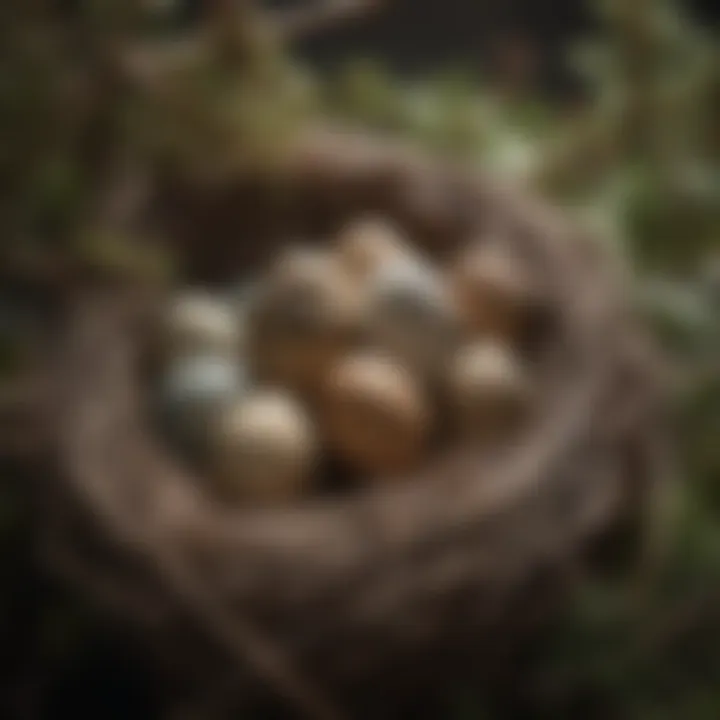
When comparing dummy eggs to real eggs, the behavioral responses of finches can differ significantly. Real eggs trigger various instinctual responses in breeding finches, such as incubation behavior and protective instincts. In contrast, dummy eggs can simulate these conditions without the potential challenges that real eggs might introduce. For example, dummy eggs help maintain the nesting cycle while preventing issues like egg binding or premature hatching.
Finches may display nesting behaviors more effectively with dummy eggs in place. They will often engage in activities such as fluffing the nest, brooding, and foraging. Moreover, with dummy eggs, there is less risk of distress related to actual egg viability. This can be particularly beneficial for novice breeders who may not have the experience or knowledge to address problems that arise with real eggs. The ability to replicate a natural environment fosters confidence in the breeding process.
Physiological Effects
The physiological impacts of dummy eggs on finches can vary but are generally less stress-inducing compared to real eggs. Coincidentally, by alleviating stress, breeders can ensure that their finches maintain better overall health during the breeding process. The absence of real eggs can reduce the likelihood of complications such as egg retention or infections that may occur with real eggs.
Dummy eggs made from various materials can also mimic the feel and weight of real eggs, which helps to maintain natural instincts in finches. When using dummy eggs, it is essential to monitor the behavior and health of the finches to ensure that they adapt well to the change. Look for any changes in feeding habits or aggression, which could signal discomfort with the dummy eggs.
In summary, a comparative analysis with real eggs ultimately helps finch owners understand their pets' behaviors and physiological responses better. Choosing to use dummy eggs can lead to a more controlled and stress-free breeding environment, playing a significant role in the successful management of finch breeding."
Expert Recommendations
The utilization of dummy eggs in finch care is a subject that deserves thoughtful scrutiny and responsible application. Expert recommendations provide a structured approach for pet owners. This section encompasses specific elements essential for successful integration into breeding practices.
Dummy eggs are not merely a replacement for real eggs; they are tools that should be chosen wisely and used strategically. Misuse or misunderstanding can lead to negative consequences not just for the finches but for the overall breeding dynamic. Therefore, relying on expert advice is crucial.
Choosing Reliable Sources for Dummy Eggs
When selecting dummy eggs, reliability and quality must be prioritized. Not all dummy eggs are created equal. There is a range of materials like plastic, ceramic, and even paper-mâché. Here are some specific pointers for finding trustworthy sources:
- Research Reputable Brands: Look for brands known for quality pet products. Brands like Kaytee and Zupreem are notable mentions, as they provide tested and safe materials.
- Read Reviews and Testimonials: Customer feedback can reveal a lot about the product's effectiveness and safety. Check forums like Reddit where experiences are shared among finch owners.
- Check Certifications: Look for attributes like non-toxicity and suitability for birds. Certified products ensure that you are not using harmful substances.
By ensuring you choose reliable sources for dummy eggs, you not only enhance the experience for your finches but also support their health and breeding success.
Best Practices for Usage
Implementing best practices goes beyond merely placing dummy eggs in a nest. It requires understanding and monitoring the finches’ behavior. Here are guidelines to follow for optimal usage:
- Assess Timing for Introduction: Introduce dummy eggs when the finches are in the early stage of nesting. This helps in simulating a more natural environment. Avoid sudden changes to prevent confusion or distress.
- Monitor Nesting Behavior: Observe how the finches interact with the dummy eggs. Their behavior can inform you if they are comfortable or if modifications are needed.
- Rotate Dummy Eggs: Periodically replace the dummy eggs to maintain hygiene and avoid wear and tear. This maintains the interest of the birds and reduces the risk of illness.
- Limit External Factors: Create a quiet and stress-free environment during the breeding season. This helps foster a calm atmosphere for the finches, increasing the odds of successful breeding.
The successful application of best practices for dummy eggs ensures not only the wellbeing of your finches but also enhances their breeding success.
Correct usage of dummy eggs can lead to a more fulfilled breeding cycle and healthy offspring.
Closure: The Value of Dummy Eggs
The usage of dummy eggs in finch care cannot be overstated. These objects play a pivotal role in simulating a natural environment, enhancing the breeding practices for finch enthusiasts. Dummy eggs serve multiple functions that contribute positively to the well-being of finches, particularly in their nesting behavior and overall health.
One significant aspect is the psychological comfort dummy eggs provide to birds that exhibit nesting instincts. By placing dummy eggs in the nesting box, finches can engage in their natural behaviors such as laying, incubating, and caring for the eggs. This simulation can lead to a reduction in stress levels during breeding periods. When finches feel secure and engaged, they tend to be more active and healthier.
Dummy eggs can also serve as tools for education, allowing pet owners to understand finch behavior in a controlled way. Observing how finches react to dummy eggs can reveal insights into their breeding habits and social structures. By interpreting the birds' interactions with these objects, owners can learn more about their pets and tailor care to meet their specific needs.
Key Points About the Value of Dummy Eggs:
- Encouragement of Natural Behaviors: Promotes instinctual actions like nesting and egg care.
- Stress Reduction: Helps finches feel secure during reproductive cycles.
- Behavioral Insights: Offers valuable information regarding finch breeding habits.
The role of dummy eggs extends beyond mere simulation; they facilitate learning opportunities for both the finches and their owners.
Further Reading and Resources
Importance of Research
Diving into specialized literature and community forums can shed light on various aspects of finch care. These resources provide research-backed data and anecdotal evidence from seasoned finch enthusiasts. Here are some key benefits:
- Informed Decision-Making: Access to expert opinions helps pet owners choose the right materials and methods for using dummy eggs. It instills confidence in their practices.
- Behavioral Insights: Resources often detail the nuanced behaviors of finches influenced by the presence of dummy eggs, aiding owners in anticipating and understanding their birds' reactions.
- Tips from the Community: Engaging with online communities like Reddit or specialized Facebook groups can offer practical tips and unique experiences that aren't always found in formal literature.
Recommended Reads
To facilitate this learning journey, the following resources may be particularly beneficial:
- Wikipedia: A general overview of the subject can be found at Wikipedia which covers various finch species and their behaviors.
- Britannica: More in-depth articles on breeding behaviors and avian care can be accessed through Britannica.
- Forums and Discussion: Platforms like Reddit offer a space where finch owners share their experiences and recommendations regarding dummy eggs and breeding.
- Social Media Groups: Engaging with communities on Facebook can provide real-time advice and a wealth of shared knowledge amongst finch enthusiasts.







